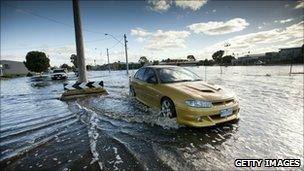Australia floods: Queensland launches inquiry
- Published

The flood waters have left swathes of mud and debris behind them
Queensland Premier Anna Bligh has announced an inquiry into flooding that has devastated swathes of the Australian state.
Ms Bligh said that the inquiry would look at issues including the operation of dams and would serve as an investment in the state's future.
Treasurer Wayne Swan has warned the floods could be the costliest natural disaster in Australia's history.
Further south, the state of Victoria is also braced for floods.
Water has already swamped some of the state's northern towns and is threatening 1,400 homes in 43 others. Some 3,500 people have left their homes so far.
In Horsham, 300km (187 miles) north-west of Melbourne, residents are expecting a peak on the Wimmera River on Tuesday to divide their town in two.
Water has already started flowing into some houses and 350 residents have been evacuated from their homes. More than 10,000 sandbags have been used by residents.
'Better prepared'
Announcing the A$15m ($14.8m, £9.3m) Commission of Inquiry, Premier Anna Bligh said the time had come to "forensically examine" the chain of events.
"I see this as an investment in our future safety, an investment in being better prepared for an event like this in the future," she said.

Residents in Horsham are expecting their town to suffer severe floods on Tuesday
"I also think we owe it to those people who have lost loved ones and those who have lost their lives to honour their memory by learning the lessons of this flood."
She said that the commission, which will deliver an interim report in August and full findings in a year, would assess warning systems, government planning and the emergency response.
One of the deputy commissioners will be a dam expert. Questions have been raised as to why water levels in the Wivenhoe dam - west of Brisbane - were not reduced in preparation for the flooding.
On Monday the toll from the flooding rose again to 20, after the body of a man was found in the Lockyer Valley area and a flood-related death was confirmed in Ipswich. Ten more people are still missing.
Flash floods hit the Lockyer valley area west of Brisbane on 10 January, before flood waters moved to Brisbane, Australia's third-largest city.
Dozens of suburbs were submerged and residents are continuing to clean up swathes of mud and debris.
Rebuilding costs
Mr Swan has warned of a severe financial impact.
"It looks like this is possibly going to be, in economic terms, the largest natural disaster in our history," he said.
"This is very big. It's not just something which is going to occupy our time for the next few months. It will be a question of years as we go through the rebuilding."
The floods have been blamed on the La Nina weather pattern in the Pacific.